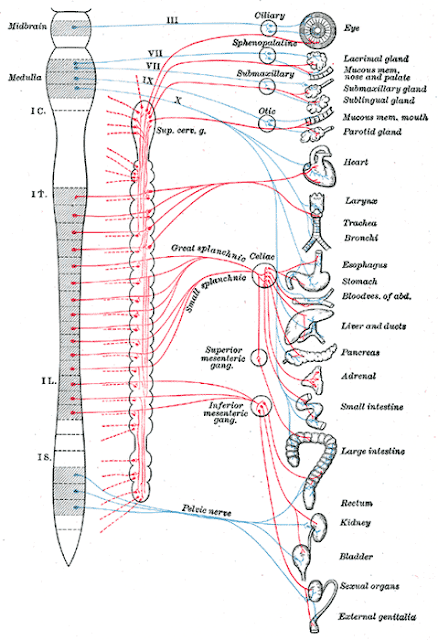Parasympathetic Nervous System Activation
Parasympathetic Nervous System Activation
Gaining context
 The Autonomic Nervous System has two parts: the sympathetic and the parasympathetic. These two structures represent polarities along the spectrum of change within the body. The diagram below shows the the parasympathetic nervous system (PNS) in blue and the sympathetic nervous system (SNS) in red. Notice that both are intimately connected to all areas of the body. In youth, the PNS dominates and the SNS only activates in cases were fight or flight is required. Normally the SNS effects are short lived in the body. However, as one ages, the SNS becomes more active, and the PNS becomes less active.
The Autonomic Nervous System has two parts: the sympathetic and the parasympathetic. These two structures represent polarities along the spectrum of change within the body. The diagram below shows the the parasympathetic nervous system (PNS) in blue and the sympathetic nervous system (SNS) in red. Notice that both are intimately connected to all areas of the body. In youth, the PNS dominates and the SNS only activates in cases were fight or flight is required. Normally the SNS effects are short lived in the body. However, as one ages, the SNS becomes more active, and the PNS becomes less active. Sympathetic Nervous System
The SNS is responsible for the 'fight, flight, or freeze' response. When the SNS is activated, the body creates neruochemicals associated with stress, such as acetylcholine, norepinephrine, adrenaline, and cortisol. These stimulate an adrenergic response which leads to, increased perspiration, pupil dilation, increased heart rate and blood pressure (feeling stressed.)Parasympathetic Nervous System
The PNS is associated with 'rest and digest' as well as 'reproduce' and, most importantly for us, 'heal.' When the PNS activates, the body produces oxytocin, serotonin, dopamine and various endorphins. The effects are improved sleep, increased fertility, rejuvenation, and better digestion. By balancing the PNS and the SNS with the technique below, your nervous system will reset to a condition associated with a robust, youthful physiology. Resetting the autonomic nervous system is a vital step in reversing the aging process.
Awakening the Parasympathetic Nervous System to Reduce Stress and Promote Healing
The Vagus Nerve
The vagus nerve connects the whole autonomic nervous system. This great nerve wonders through the body, connecting all of the organs, as illustrated in the diagram above. When stimulated in an intelligent manner, the vagus nerve will balance the autonomic nervous system, increasing PNS activity and promoting healing. Connection with the vagus nerve is a key to balancing the autonomic nervous system.
The vegas nerve comes closest to the surface of the skin in the ear, as seen in the diagram below. It can also be 'touched' along the sides of the neck, and in the cavity behind the ear lobe.
The vegas nerve comes closest to the surface of the skin in the ear, as seen in the diagram below. It can also be 'touched' along the sides of the neck, and in the cavity behind the ear lobe.
Finger Chakras for Massage
There are energy centers (chakras) at the ends of each finger. The thumb and middle finger in particular, carry more energy than the other fingers. This is because meridians which run through the body come to an end in these fingers. Please see diagram below. Therefore it is best to practice the following massage with these two fingers if you can.
How to Do the Massage
With the middle finger and thumb, massage the inner area of the ear (red area in diagram above.) If you touch skin to skin, this will activate the PNS in a direct and very physical manner. However, if you do not touch skin to skin, but keep the finger a little away from the actual ear, you will be massaging energy to energy. Both methods are very valuable and will promote a range of beneficial effects.Also, without touching skin to skin, run the thumbs from just below the adam's apple to the cavity behind the earlobes. Very slowly and gently move the thumbs up and down to awaken the etheric level of the vagus nerve in the neck area. The vagus nerve is far away enough from the surface of the skin at this point, that there isn't much purpose in trying to reach it physically. However, the neck area is very responsive to energy to energy massage. This is why I suggest that the massage in this area is done with only the very lightest touch, or no touch at all. It is good to do the movement at least 11 times.




Comments
Post a Comment